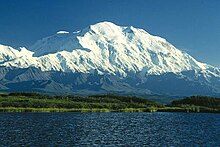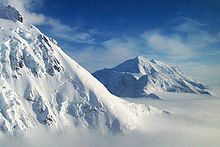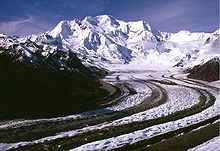Fourteener
This article includes a list of references, related reading, or external links, but its sources remain unclear because it lacks inline citations. (April 2009) |
 |
 |
 |
 |
 |
 |
 |
 |
 |
 |
 |
 |
 |
In mountaineering terminology in the United States, a fourteener is a mountain that exceeds 14,000 feet (4,267.2 m) above mean sea level. The importance of fourteeners is greatest in Colorado, which has the majority of such peaks in North America. Climbing all of Colorado's fourteeners is a popular pastime among peak baggers. Many people also try to climb all of the fourteeners in the contiguous United States. Several ski mountaineers have also completed ski descents of all the Colorado fourteeners, and the first attempts are being made to complete ski descents of all U.S. fourteeners.
Qualification criteria
Not all summits over 14,000 feet qualify as fourteeners[1]. Summits which qualify are those considered by mountaineers to be independent. Objective standards for independence include topographic prominence and isolation (distance from a higher summit), or a combination of the two. However fourteener lists do not always consistently use such objective rules. Also, there is some debate as to whether or not peaks of 15,000 feet or more should be referred to as "fourteeners"; this article will refer to them as such.
A rule commonly used by mountaineers in the contiguous United States is that a peak must have at least 300 feet (91.4 m) of prominence to qualify. By this rule, Colorado has 53 (plus or minus 1) fourteeners, California has 12, and Washington has 2. However, the subsidiary summit of Liberty Cap in Washington (one of the summits of Mount Rainier), at 14,112 feet and 492 feet of prominence, is often not counted as a fourteener despite meeting the prominence criteria.
According to the Mountaineering Club of Alaska, it is standard in Alaska to use a 500 foot prominence rule rather than a 300 foot rule.[citation needed] By this rule, Alaska has at least 21 peaks over 14,000 feet and its 12 highest peaks exceed 15,000 feet (4,572 m).
For comparison, Canada has 15 fourteeners, and Mexico has 8; however the importance of the arbitrary 14,000 foot mark is minimal outside of the U.S. (due in large part to the use of the metric system). In Europe, it is very common to attempt to climb all of the independent 4,000 metres (13,000 ft) peaks in the Alps; that pastime roughly corresponds to fourteener-bagging in the U.S., although the European peaks are more technical climbs in general.
List of United States fourteeners
The following table lists the fourteeners which satisfy the 300 foot prominence rule (for Colorado, California, and Washington) or the 500 foot rule (for Alaska). In other words, it is a list of the highest independent summits in the United States. Note that even with a specified rule, there are a few ambiguous borderline cases, due to the unavoidable imprecision of surveys; the prominence range for these peaks is noted. Also note that due to imprecision of elevations, the order given below is not certain; in particular, different vertical data lead to uncertainties in the ranking. Elevations are given in feet.
The following are peaks that are sometimes considered fourteeners but do not meet the criteria for the above list:
- Mount McKinley, South Buttress, 15,885, Alaska. Prominence = 285-385 feet.
- Mount McKinley, East Buttress high point, 14,730, Alaska. Prominence = 330-430 feet.
- Mount McKinley, Browne Tower, 14,530, Alaska. Prominence = 25-125 feet. It is unclear why this became included on some fourteener lists.
- Mount Cameron, 14,238, Colorado. Prominence = 118 feet.
- El Diente Peak, 14,159, Colorado. Prominence = 239 feet. On many fourteener lists.
- Point Success, 14,158, Washington. Prominence = 118 feet.
- Polemonium Peak, 14,080+, California. Prominence = 160-240 feet.
- Starlight Peak, 14,080, California. Prominence = 80-160 feet.
- North Conundrum Peak, 14,040+, Colorado. Prominence = 200-280 feet.
- North Eolus, 14,039, Colorado. Prominence = 159-199 feet.
- North Maroon Peak, 14,014, Colorado. Prominence = 234 feet. On many fourteener lists.
- Thunderbolt Peak, 14,003, California. Prominence = 223 feet.
See also
- 4000 meter peaks of Alaska
- 4000 meter peaks of California
- 4000 meter peaks of Colorado
- 4000 meter peaks of North America
- 4000 meter peaks of the United States
- List of California fourteeners
- List of Colorado fourteeners
- List of highest mountains of North America (uses a stricter cutoff)
- Thirteener
References
- ^ Blake, Kevin S. 2002. Colorado Fourteeners and the Nature of Place Identity. Geographical Review 92(2): 155-179.
- ^ See Mount Blackburn on Topozone, which shows an interpolated prominence of 536 feet.
- ^ While the high point of the East Buttress (14,730 feet) has a prominence of only 380 feet, the most prominent point of the Buttress has a prominence of 600 feet, qualifying it for this list.
- ^ Mount Bross has a prominence of between 292 and 332 feet.
- ^ "NGS Data Sheet for Pikes Peak". National Geodetic Survey.
- ^ Challenger Point has a prominence of between 280 and 320 feet.
- ^ Although Mt. Muir's prominence by interpolating between contours is 331 feet, reliable altimeter-based measurements suggest that it has only 276 feet of prominence (plus or minus 20 feet). Thus, Mt. Muir is probably not a fourteener. VRMC California Thirteeners
External links
- 14ers.com: Home of Colorado's Fourteeners
- Fourteener list on peakbagger.com with prominence information
- peaklist.org (More prominence information for high-prominence peaks)
- Information on the fourteeners in Colorado
- Trip reports from Colorado Peaks
- California Thirteeners (VRMC) (Includes interactive maps)
- California Fourteeners (VRMC) (Includes interactive maps)
